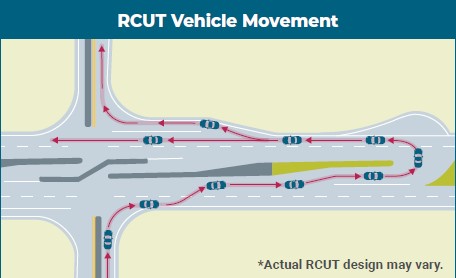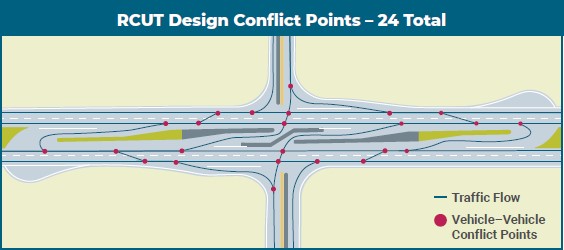Restricted Crossing U-Turn (RCUT) Intersections in Nebraska
Restricted Crossing U-Turn Intersections, otherwise known as RCUTs, have been shown to decrease right-angle crashes on four-lane divided highways. An RCUT intersection requires a change in how drivers cross and turn onto the highway from side roads by preventing direct crossing and left-turn movements. Relative to many other improvements, it is a low-cost treatment that can be quickly implemented, requires minimal to no property acquisition or relocation of homes and businesses, and minimizes environmental impacts.
Information Sheet | School Handout

How does it work?
At an RCUT intersection, motorists approaching divided highways from a side road are not allowed to make left turns or cross traffic; instead, they are required to turn right onto the highway and then make a U-turn at a designated median opening. This reduces potential conflict points and enhances safety. Generally, delay caused by waiting to cross both sets of lanes or by a traffic signal is greater than the delay caused by the RCUT movement. Traffic will still be able to turn left onto side roads from the highway.
Why does it work?
A typical four-lane divided highway intersection has 42 possible vehicle conflict points. RCUTs reduce conflict points to 24. With an RCUT, drivers from the side road only have to be concerned with one direction of traffic on the highway at a time. Drivers do not need to wait for a gap in both directions to cross the highway. Certain four-lane divided highway intersections have an elevated risk of severe right-angle crashes or “T-bone” crashes. RCUTs have been successfully implemented in several states and are generally recommended for highways that would otherwise require signalized intersections, grade-separated interchanges, or access restriction.


Benefits
RCUT intersections significantly reduce the potential for crashes by allowing drivers to navigate through one lane of highway traffic at a time. An RCUT intersection reduces vehicle conflict points by over 40%. If vehicles are involved in a crash at an RCUT conflict point, crashes are generally less severe than those at a conventional intersection.
- Increased time savings. At conventional intersections, side road drivers must wait for a gap in both directions of highway traffic at the same time in order to safely cross the highway. With RCUTs, drivers only wait for a gap in one direction of highway traffic at a time, making it quicker, easier, and safer for side road drivers to turn left or cross the highway. For drivers on the highway, RCUTs do not delay their trip like the use of a traffic signal on a highway could.
- Improved Cost Effectiveness. Instead of constructing a more expensive, grade-separated interchange at highway intersections, RCUTs are an innovative solution that address safety issues for some conventional intersections at a greatly reduced cost.
LEAVE A COMMENT